Related Research Articles
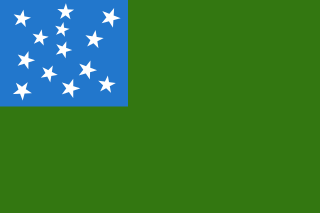
The Green Mountain Boys were a militia organization first established in 1770 in the territory between the British provinces of New York and New Hampshire, known as the New Hampshire Grants and later in 1777 as the Vermont Republic. Headed by Ethan Allen and members of his extended family, it was instrumental in resisting New York's attempts to control the territory, over which it had won de jure control in a territorial dispute with New Hampshire.
A county seat is an administrative center, seat of government, or capital city of a county or civil parish. The term is used in Canada, China, Romania, Taiwan, Hungary and the United States. County towns have a similar function in the United Kingdom and Republic of Ireland, as well as historically in Jamaica.
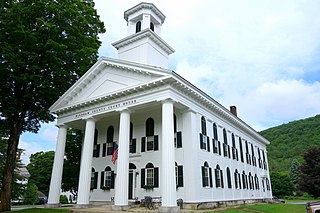
Windham County is a county located in the U.S. state of Vermont. As of the 2010 census, the population was 44,513. The shire town is Newfane, and the largest municipality is the town of Brattleboro.

Brattleboro, originally Brattleborough, is a town in Windham County, Vermont, United States. The most populous municipality abutting Vermont's eastern border with New Hampshire, which is the Connecticut River, Brattleboro is located about 10 miles (16 km) north of the Massachusetts state line, at the confluence of Vermont's West River and the Connecticut. In 2010, Brattleboro's population was 12,046.

Westminster is a village in Windham County, Vermont, United States. The population was 276 at the 2000 census. Most of the village is listed on the National Register of Historic Places in 1988 as the Westminster Village Historic District.

Westminster is a town in Windham County, Vermont, United States. The population was 3,178 at the 2010 census.
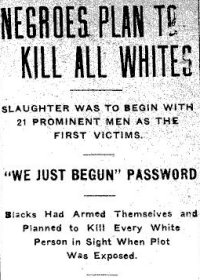
The Elaine massacre occurred on September 30–October 1, 1919 at Hoop Spur in the vicinity of Elaine in rural Phillips County, Arkansas. Some records of the time state that eleven black men and five white men were killed. Estimates of deaths made in the immediate aftermath of the Elaine Massacre by eyewitnesses range from 50 to "more than a hundred". Walter Francis White, an NAACP attorney who visited Elaine shortly after the incident stated "... twenty-five Negroes killed, although some place the Negro fatalities as high as one hundred". More recent estimates of the number of black people killed during this violence are higher than estimates provided by the eyewitnesses, recently ranging into the hundreds. The white mobs were aided by federal troops and terrorist organizations like the Ku Klux Klan. According to the Encyclopedia of Arkansas, "the Elaine Massacre was by far the deadliest racial confrontation in Arkansas history and possibly the bloodiest racial conflict in the history of the United States".

The New Hampshire Grants or Benning Wentworth Grants were land grants made between 1749 and 1764 by the colonial governor of the Province of New Hampshire, Benning Wentworth. The land grants, totaling about 135, were made on land claimed by New Hampshire west of the Connecticut River, territory that was also claimed by the Province of New York. The resulting dispute led to the eventual establishment of the Vermont Republic, which later became the U.S. state of Vermont.

The geologic history of Vermont begins more than 450 million years ago during the Cambrian and Devonian periods.

Jonathan Hunt was an American pioneer, landowner and politician from Vernon, Vermont. He served as Lieutenant Governor of Vermont and was a member of the prominent Hunt family of Vermont.
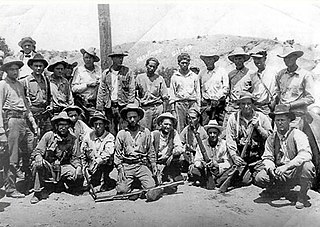
The posse comitatus, in common law, is a group of people mobilized by the conservator of peace – typically a sheriff – to suppress lawlessness or defend the county. The posse comitatus originated in ninth century England simultaneous with the creation of the office of sheriff. Though generally obsolete throughout the world, it remains theoretically, and sometimes practically, part of the United States legal system.
The Mason County War, sometimes called the Hoodoo War in reference to masked members of a vigilance committee, was a period of lawlessness ignited by a "tidal wave of rustling" in Mason County, Texas in 1875 and 1876. The violence entailed a series of mob lynchings and retaliatory murders involving multiple posses and law enforcement factions, including the Texas Rangers. The conflict took the lives of at least 12 men and resulted in a climate of bitter "national prejudice" against local German-American residents in the following years.
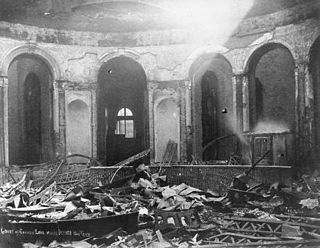
The Cincinnati riots of 1884, also known as the Cincinnati Courthouse riots, were caused by public outrage over the decision of a jury to return a verdict of manslaughter in what was seen as a clear case of murder. A mob in Cincinnati, Ohio, United States, attempted to find and lynch the perpetrator. In the violence that followed over the next few days, more than 50 people died and the courthouse was destroyed. It was one of the most destructive riots in American history.
Thomas Chandler Jr. was a Vermont colonial leader who was a founder of Chester, Vermont and served as Speaker of the Vermont House of Representatives. In addition, he was Vermont's first Secretary of State.
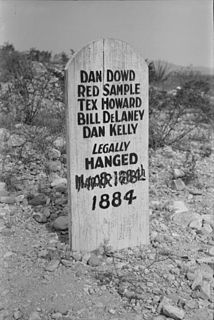
The Bisbee massacre occurred in Bisbee, Arizona, on December 8, 1883, when six outlaws who were part of the Cochise County Cowboys robbed a general store. Believing the general store's safe contained a mining payroll of $7,000, they timed the robbery incorrectly and were only able to steal between $800 to $3,000, along with a gold watch and jewelry. During the robbery, members of the gang killed four people, including a lawman and a pregnant woman. Six men were convicted of the robbery and murders. John Heath, who was accused of organizing the robbery, was tried separately and sentenced to life in prison. The other five men were convicted of murder and sentenced to hang.
In Forsyth County, Georgia, in September 1912 two separate attacks on white women resulted in black men being accused as suspects. One white woman accused two black men of breaking into her home in Big Creek Community and one of raping her. Another teenage woman was fatally beaten and raped in the Oscarville Community. Earnest Knox was linked to the Oscarville murder along with his half brother by a hair comb sold to him at the Oscarville store. When confronted, he confessed to the Sheriff and implicated his half brother and mother’s livein boyfriend. His mother testified against the sons during the jury trial which sentenced both to hanging. 21 days later the sentence was carried out.
Samuel Knight was a legal and political figure in Vermont during its period as an independent republic and the early years of its statehood. Among the offices in which he served were Associate Justice of the Vermont Supreme Court, and Chief Justice (1791-1793).

Luke Knowlton was a political leader of colonial Vermont, the Vermont Republic, and the state of Vermont. He served as a Justice of the Vermont Supreme Court, a member of the Governor's Council, and a member of the Vermont House of Representatives.

The Newberry Six lynchings took place in Newberry, Alachua County, Florida, on August 18, 1916.

African-American man, Jordan Jameson was lynched on November 11, 1919, in the town square of Magnolia, Columbia County, Arkansas. A large white mob seized Jameson after he allegedly shot the local sheriff. They tied him to a stake and burned him alive.
References
- ↑ "The Massacre at Westminster, Vermont". Vermont Genealogy. Vermont Genealogy. Retrieved 21 March 2018.
- ↑ "OLD BENNINGTON". Revolutionary Say. Retrieved 21 March 2018.